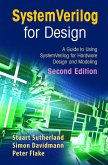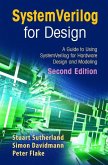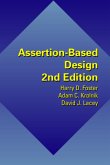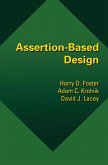Verification is too often approached in an ad hoc fashion. Visually inspecting simulation results is no longer feasible and the directed test-case methodology is reaching its limit. Moore's Law demands a productivity revolution in functional verification methodology.
Writing Testbenches Using SystemVerilog offers a clear blueprint of a verification process that aims for first-time success using the SystemVerilog language. From simulators to source management tools, from specification to functional coverage, from I's and O's to high-level abstractions, from interfaces to bus-functional models, from transactions to self-checking testbenches, from directed testcases to constrained random generators, from behavioral models to regression suites, this book covers it all.
Writing Testbenches Using SystemVerilog presents many of the functional verification features that were added to the Verilog language as part of SystemVerilog. Interfaces, virtual modports, classes, program blocks, clocking blocks and others SystemVerilog features are introduced within a coherent verification methodology and usage model.
Writing Testbenches Using SystemVerilog introduces the reader to all elements of a modern, scalable verification methodology. It is an introduction and prelude to the verification methodology detailed in the Verification Methodology Manual for SystemVerilog.
If you survey hardware design groups, you will learn that between 60% and 80% of their effort is dedicated to verification. This may seem unusually large, but I include in "verification" all debugging and correctness checking activities, not just writing and running testbenches. Every time a hardware designer pulls up a waveform viewer, he or she performs a verification task. With today's ASIC and FPGA sizes and geometries, getting a design to fit and run at speed is no longer the main challenge. It is to get the right design, working as intended, at the right time. Unlike synthesizable coding, there is no particular coding style nor language required for verification. The freedom of using any l- guage that can be interfaced to a simulator and of using any features of that language has produced a wide array of techniques and approaches to verification. The continued absence of constraints and historical shortage of available expertise in verification, c- pled with an apparent under-appreciation of and under-investment in the verification function, has resulted in several different ad hoc approaches. The consequences of an informal, ill-equipped and understaffed verification process can range from a non-functional design requiring several re-spins, through a design with only a s- set of the intended functionality, to a delayed product shipment.
Writing Testbenches Using SystemVerilog offers a clear blueprint of a verification process that aims for first-time success using the SystemVerilog language. From simulators to source management tools, from specification to functional coverage, from I's and O's to high-level abstractions, from interfaces to bus-functional models, from transactions to self-checking testbenches, from directed testcases to constrained random generators, from behavioral models to regression suites, this book covers it all.
Writing Testbenches Using SystemVerilog presents many of the functional verification features that were added to the Verilog language as part of SystemVerilog. Interfaces, virtual modports, classes, program blocks, clocking blocks and others SystemVerilog features are introduced within a coherent verification methodology and usage model.
Writing Testbenches Using SystemVerilog introduces the reader to all elements of a modern, scalable verification methodology. It is an introduction and prelude to the verification methodology detailed in the Verification Methodology Manual for SystemVerilog.
If you survey hardware design groups, you will learn that between 60% and 80% of their effort is dedicated to verification. This may seem unusually large, but I include in "verification" all debugging and correctness checking activities, not just writing and running testbenches. Every time a hardware designer pulls up a waveform viewer, he or she performs a verification task. With today's ASIC and FPGA sizes and geometries, getting a design to fit and run at speed is no longer the main challenge. It is to get the right design, working as intended, at the right time. Unlike synthesizable coding, there is no particular coding style nor language required for verification. The freedom of using any l- guage that can be interfaced to a simulator and of using any features of that language has produced a wide array of techniques and approaches to verification. The continued absence of constraints and historical shortage of available expertise in verification, c- pled with an apparent under-appreciation of and under-investment in the verification function, has resulted in several different ad hoc approaches. The consequences of an informal, ill-equipped and understaffed verification process can range from a non-functional design requiring several re-spins, through a design with only a s- set of the intended functionality, to a delayed product shipment.
From the reviews: "The book provides verification engineers with an introduction to all elements of a modern, scalable verification environment and a foundation for adopting the advanced verification methodology detailed in the Verification Methodology Manual for SystemVerilog ... . 'Mr. Bergeon has once again written a book that is a standard-bearer for engineers tasked with verifying RTL and systems design' ... . the strategies and methodologies put forth by Mr. Bergeron has become more important to the success of every verification project." (EE Times, April, 2006)









